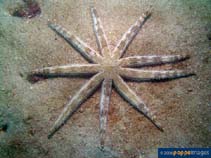Luidia maculata Müller & Troschel, 1842
Warning: DOMDocument::load(): SSL operation failed with code 1. OpenSSL Error messages: error:140770FC:SSL routines:SSL23_GET_SERVER_HELLO:unknown protocol in C:\Apache24\htdocs\includes\SpeciesSummary.lib.php on line 1236
Warning: DOMDocument::load(): Failed to enable crypto in C:\Apache24\htdocs\includes\SpeciesSummary.lib.php on line 1236
Warning: DOMDocument::load(https://sealifebase.nrm.se/webservice/AquaMaps/getAMap.php?genus=Luidia&species=maculata): failed to open stream: operation failed in C:\Apache24\htdocs\includes\SpeciesSummary.lib.php on line 1236
Warning: DOMDocument::load(): I/O warning : failed to load external entity "https://sealifebase.nrm.se/webservice/AquaMaps/getAMap.php?genus=Luidia&species=maculata" in C:\Apache24\htdocs\includes\SpeciesSummary.lib.php on line 1236
Classification / Names Common names | Synonyms | CoL | ITIS | WoRMS
| Paxillosida | Luidiidae
Environment: milieu / climate zone / depth range / distribution range पारिस्थितिकी
प्रवाल-भित्ति संयुक्त; गहराई सीमा 0 - 512 m (Ref. 106682). Tropical
वितरण देश | ऐफ ऐ ओ क्षेत्र | Ecosystems | संयोग | भूमिका
Indo-Pacific. Tropical to subtropical.
Length at first maturity / आकार / वज़न / Age
Maturity: Lm ? range ? - ? cm Max length : 60.0 cm WD पुल्लिंग / अलिंग; (Ref. 129602)
Short description आकृति विज्ञान
A large-sized starfish with seven to nine arms, eight being the most common. Aboral surface usually yellowish-brown, with four to six distinctive dark blotches on the arms. Central disc is very small, and long arms are tapered to a pointed end. Body surface is densely covered by abactinal paxillae, also having small sharp spines along the two sides of arms. Ambulacral groove is with two rows of tube feet that do not retract into the body.
Occurs on soft bottoms, exposed or buried in the sand (Also Ref. 129602) at depths of 0 to 90 m (Ref. 800). Also found on seagrass (Ref. 102259). Carnivorous and feeds on other echinoderms and molluscs (Ref. 800). Swallows prey as a whole, instead of protruding the stomach out to digest a prey (Ref. 125532).
Life cycle and mating behavior परिपक्व अवधि | पुनरुत्पत्ति | मछलीऔ का अंडे देना | अंडे | Fecundity | लार्वा
Members of the class Asteroidea exhibit both asexual (regeneration and clonal) and sexual (gonochoric) means of reproduction. Life cycle: Embryos hatch into planktonic larvae and later metamorphose into pentamorous juveniles which develop into young sea stars with stubby arms.
Main reference
संदर्भ | संयोजक | सहयोगीयो
Schoppe, S. 2000. (Ref. 800)
IUCN Red List Status (Ref. 130435)
CITES status (Ref. 108899)
Not Evaluated
CMS (Ref. 116361)
Not Evaluated
Threat to humans
Harmless
Human uses
| FishSource |
साधन
अधिक जानकारी
इंटरनेट स्रोत
BHL | BOLD Systems | CISTI | DiscoverLife | FAO(Publication : search) | Fishipedia | GenBank (genome, nucleotide) | GloBI | Gomexsi | Google Books | Google Scholar | Google | PubMed | Tree of Life | Wikipedia (Go, खोज) | Zoological Record
Estimates based on models
Preferred temperature
(Ref. 115969): 24.2 - 29, mean 28 (based on 1518 cells).
Price category
(Ref. 80766):
Unknown.



